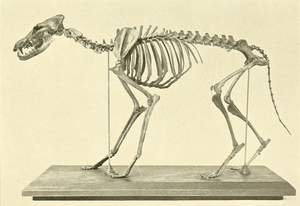Pleistocene coyote facts for kids
Quick facts for kids Pleistocene coyote |
|
|---|---|
 |
|
| Scientific classification |
|
| Kingdom: | Animalia |
| Phylum: | Chordata |
| Class: | Mammalia |
| Order: | Carnivora |
| Family: | Canidae |
| Genus: | Canis |
| Species: | |
| Subspecies: |
C. l. orcutti
|
| Trinomial name | |
| Canis latrans orcutti Merriam, 1910
|
|
The Pleistocene coyote (Canis latrans orcutti), also known as the Ice Age coyote, was an extinct type of coyote. It lived in western North America during the Late Pleistocene era, which was a time of ice ages. Most of its remains have been found in southern California. At least one fossil was also discovered in Idaho. This coyote was part of a group of meat-eating animals. This group included other members of the dog family like foxes, gray wolves, and dire wolves.
What Made It Special?
Compared to today's coyotes, the Pleistocene coyote was bigger and stronger. It weighed about 39 to 46 pounds. It was likely larger because it lived alongside bigger competitors and prey. Its skull and jaws were much thicker and deeper than those of modern coyotes. It also had a shorter, wider snout. Its special shearing teeth, called carnassials, were wider too. These strong features helped it handle the stress of hunting larger animals.
The Ice Age coyote probably ate more meat than today's coyotes. Its teeth were better for cutting meat. They had fewer flat surfaces for grinding plants. Its lower jaw was also deeper. Its molar teeth showed more signs of wear and breakage. This suggests these ancient coyotes ate more bones than modern ones do.
How It Lived
It's believed that the Pleistocene coyote was more social than the coyotes we see today. Many of its remains have been found at the La Brea Tar Pits. It's the third most common animal found there, after dire wolves and sabre-toothed cats. Both of these animals are thought to have lived in groups. This suggests the Ice Age coyote might have lived in groups too.
Why It Changed
The Pleistocene coyote became smaller over about 1,000 years. This change happened after a big event called the Quaternary extinction event. During this time, the climate changed a lot. Most of the large animals that the coyotes hunted died out.
Also, the Pleistocene coyotes couldn't take over the hunting role left empty by the dire wolf. Gray wolves quickly filled that spot instead. These gray wolves likely hunted the larger coyotes. This meant that natural selection favored smaller, more agile coyotes. These smaller coyotes are similar to the ones we see today. Humans also hunted the same prey animals that the coyotes relied on. This might have also affected how the Pleistocene coyote changed over time.

